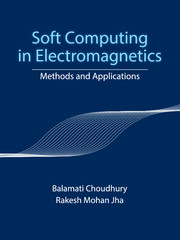Book contents
- Frontmatter
- Dedication
- Contents
- List of Figures
- List of Tables
- Preface
- Acknowledgments
- Abbreviations
- Symbols
- 1 Introduction
- 2 Soft Computing Techniques
- 3 Soft Computing in Electromagnetics: A Review
- 4 Bacterial Foraging Optimization For Metamaterial Antennas
- 5 PSO for Radar Absorbers
- 6 Characterization of Planar Transmission Lines Using ANN
- 7 Fault Detection in Antenna Arrays
- 8 Multi-Objective Particle Swarm Optimization for Active Terahertz Devices
- 9 Soft Computing based CAD Packages for EM Applications
- Author Index
- Subject Index
- References
8 - Multi-Objective Particle Swarm Optimization for Active Terahertz Devices
Published online by Cambridge University Press: 05 July 2016
- Frontmatter
- Dedication
- Contents
- List of Figures
- List of Tables
- Preface
- Acknowledgments
- Abbreviations
- Symbols
- 1 Introduction
- 2 Soft Computing Techniques
- 3 Soft Computing in Electromagnetics: A Review
- 4 Bacterial Foraging Optimization For Metamaterial Antennas
- 5 PSO for Radar Absorbers
- 6 Characterization of Planar Transmission Lines Using ANN
- 7 Fault Detection in Antenna Arrays
- 8 Multi-Objective Particle Swarm Optimization for Active Terahertz Devices
- 9 Soft Computing based CAD Packages for EM Applications
- Author Index
- Subject Index
- References
Summary
The terahertz spectrum is gaining momentum in a wide range of fields including astronomy, material characterization, tumour detection, security and detection of concealed items, etc. among others. The main obstacle in the rapid growth of terahertz applications is the lack of natural dielectrics, and of high power, efficient sources. Emergence of metamaterial science and technology has attracted researchers to design and develop terahertz devices using these artificially engineered materials. These metamaterial structures are highly resonant, restricting the terahertz applications to narrow bands. This issue can be sorted out by designing active metamaterials.
As discussed in the Chapter 5, mathematical formulation for the design of metamaterial based structures is complicated and soft computing has proven to be an efficient method to arrive at design solutions. Further, terahertz devices themselves often are complex designs being multilayer in nature with an embedded metamaterial layer. Further, to make the devices tunable, mechanisms such as the MEMS switches, diodes, etc., should be incorporated in the design. In order to achieve an optimized design with these complex mechanisms one ought to go for a multi-objective optimization computational engine. This issue has been discussed in detail in this chapter via a tunable terahertz absorber design.
Introduction to Terahertz Technology
Terahertz refers to the range of frequencies that lies within the microwave and infrared (IR) bands. It can be loosely defined as the band between 0.1–10 THz. At times, the term “submillimetre band” is used to describe frequencies lying in the 0.3–3 THz band. While systems and applications operating in the microwave and IR ranges have been well established over decades, the development of terahertz technology has been slow. However, in recent times, this technology has evolved rapidly to find major applications relating directly to human lives, especially in the field of biomedical imaging and sample identification.
Properties of terahertz spectrum
The primary reason for this slow developmental trend was the lack of terahertz sources during the early years, coupled with the fact that this range displays a natural break-down point in electric and magnetic properties in conventional materials [Ferguson and Zhang, 2009, Smith et al., 2004]. This property put constraints on the material used in the fabrication of terahertz devices.
- Type
- Chapter
- Information
- Soft Computing in ElectromagneticsMethods and Applications, pp. 155 - 181Publisher: Cambridge University PressPrint publication year: 2016



